The Key to Renewable Energy
Energy Storage Systems: Key to Using Renewable Energy

Image Source: malp/Stock.adobe.com
By Bill Schweber for Mouser Electronics
Published September 16, 2022
It’s well known that the desire for renewable energy sources has increased due to multiple factors. Among them are worries about climate change and mitigating its sources, the overall “green” push, concerns about short- and longer-term availability of traditional fossil-fuel sources (oil, gas, coal), long and often politically-risky supply chains (think natural gas supplies from Russia), and government regulations and incentives. The transition to renewable energy attracts substantial aggregate investment, estimated to be the order of >$100 billion in 2022 alone (Figure 1).
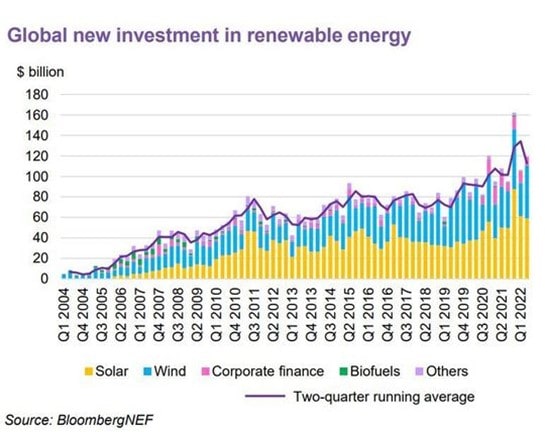
Figure 1: While there have been occasional small decreases, the overall trend of investment in renewable energy shows a clear increase, with investments in new large-scale renewable energy projects being up 12% from the same period in 2021, at $120 billion in Q1 2022. (Source: Bloomberg/NEF)
An important structural difference is between a system based on renewable sources and one using conventionally-fueled power plants. Popular renewable sources such as solar and wind are inherently intermittent in their availability. This unpredictable nature contrasts sharply with our expectations and experience when using traditional power plants, which provide the same output 24/7/365 and are not dependent on sun or wind availability.
A non-renewable-fueled power system has only two major elements: The generator as a source and the transmission lines that bring the power to the end user. In contrast, a renewable-energy arrangement requires additional functions to be a viable source:
- First, a power converter/conditioner needs to transform the “raw” captured energy into a stable, clean 120/240 VAC power, as the energy captured from the renewable source cannot be used directly.
- Second, when the renewable source is intermittent— as is often the case—the energy source-to-use path needs an energy storage system (ESS) to accept and store as it is made available from that source. It then provides it to the user as needed, even if the source is not provided immediately.
Further, a more-advanced ESS system can supply power not being used or stored back to the grid.
[A word about terminology: The terms “energy” and “power” are often used interchangeably; this does not cause confusion or misunderstandings in most cases. However, from a strictly technical perspective, they are very different but closely-related entities. Energy (watt-hours) denotes the aggregate ability to do work, while power (watts) is the rate at which energy is transferred or consumed, and work is done. A system based on renewable sources harvests energy when it is available for later use, then “spends” it when needed as power on the load.]
ESS Options Span a Range
As noted, the availability of the basic renewable energy source is only part of the broader energy puzzle. A complete system needs not only that energy source, but also storage and transmission lines (Figure 2). At present, how to implement that interim energy storage is a significant issue when building a practical, complete system based on renewable energy.
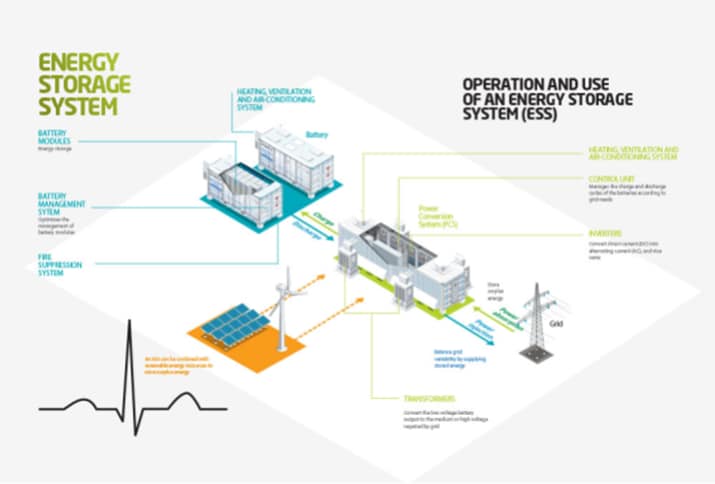
Figure 2: A complete grid-connected ESS requires much more than just the energy storage subsystem; it also needs an energy source and transmission lines. (Source: Saft/Total Energies)
The need for energy storage applies to mobile and fixed-in-place installations, and the practical options are a function of the system size and setting. As the end application gets larger or is not required to be mobile, the preliminary list of possibilities expands (Figure 3).
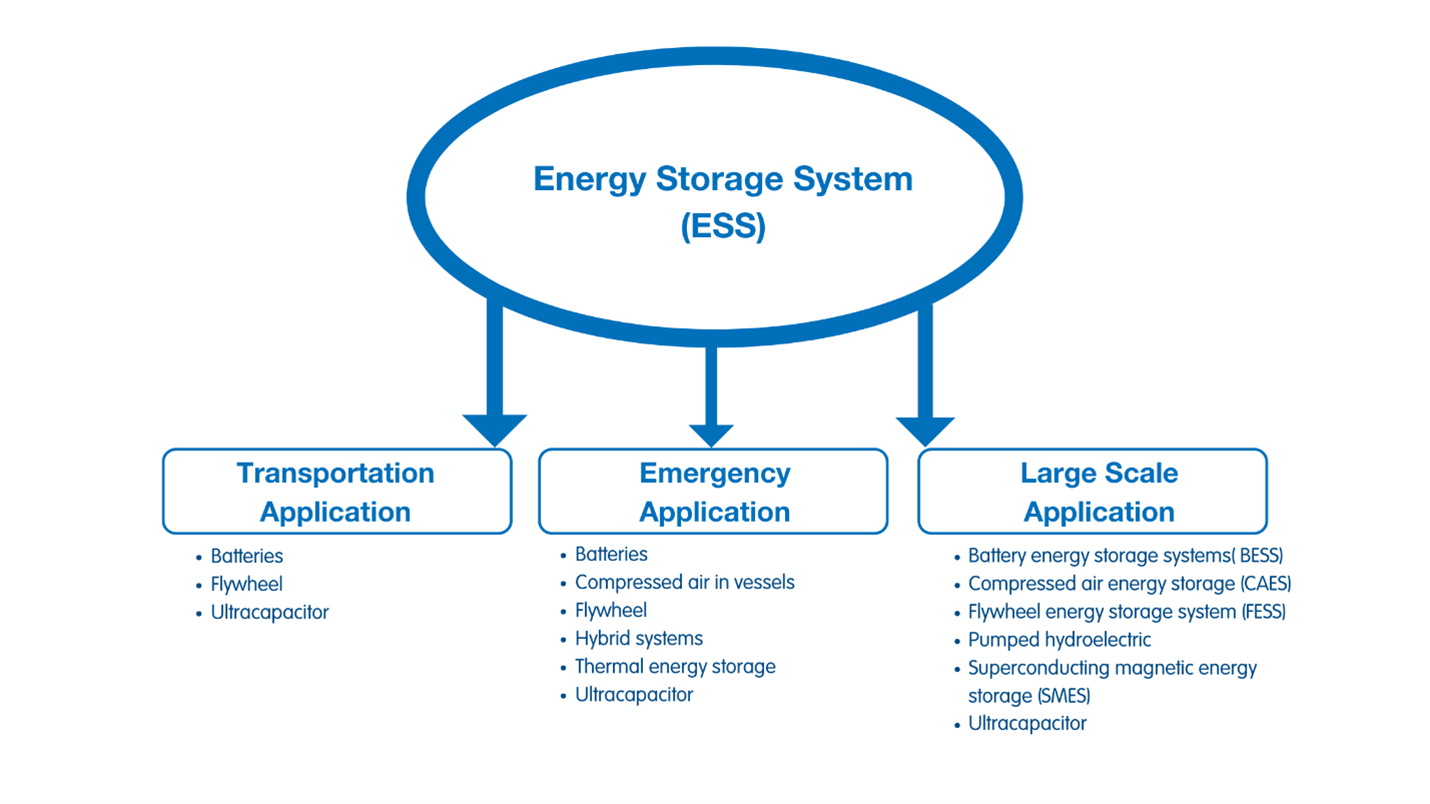
Figure 3: While there are many apparent options for energy storage, their viability is a function of siting and capacity. (Source: Mouser Electronics)
Storage options are broadly divided into mechanical, chemical, electrical, and hydraulic approaches. Among the many possibilities are:
- Using renewable energy to separate hydrogen from water, which is then stored for use in fuel cells.
- Pumping water to a higher elevation, then releasing it to flow through a turbine generator.
- Compressing air to be stored in tanks or caverns, which is then released as needed to turn a turbine generator.
- Using a motor to spin up a flywheel to store energy in the rotating mass, then using the same motor as a generator to extract the stored energy.
- Heating salts so they become molten, then allowing them to cool and extracting the stored heat energy.
- Lifting and stacking of weights using motorized winches, then letting the weights drop in controlled manner as the winch motors act as generators (Figure 4).

Figure 4: One form of energy storage via gravity uses an automated crane to lift concrete blocks weighing 35 tons and then release them in a controlled drop while turning a generator. (Source: Energy Vault)
- Using ultracapacitors, which store energy via physical arrangement of electrical charge.
- And, of course, using batteries that store and release energy using electrochemical changes.
Each of these storage options has very different performance attributes concerning:
- Energy density by weight and volume.
- Site preparation, permitting issues, and environmental impact.
- Scalability to larger-capacity installations.
- Modularity in sizing and upgrading of the storage capacity.
- Upfront, operating, and ongoing maintenance costs.
- Risks and safety issues (a major issue when you have densely-stored energy).
- Installation uncertainties and risks, operating life, and longevity.
- and many other parameters.
No single solution consistently ranks as the "best” solution across all installation scenarios (Figure 5). The most appropriate solution for a given situation is determined by careful assessment, ranking, and weighing the many attributes and concerns.
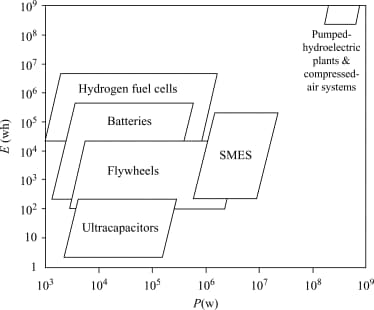
Figure 5: Energy-storage schemes present a wide range of power and energy capacities. (Source: Elsevier/Science Direct)
Batteries are an Attractive Option
Despite the availability of many energy-storage options, the rechargeable battery is often chosen due to its many favorable factors. While classic lead-acid cells and other battery chemistries can be used, lithium-based chemistries are often the preferred choice.
Lithium chemistries offer superior performance across many key requirements and excel significantly for some key attributes. For example, their energy density by weight and volume is high, site preparation requirements are modest, and they are silent, have no moving parts, and require minimal maintenance.
Another critical benefit of battery-based storage is that the initial design can easily be sized and scaled to fit the requirements. Further, battery packs are inherently modular. Additional battery modules can be added with only modest additional design effort if more capacity is needed later. This is in sharp contrast to a hydro-storage/gravity approach, for example.
In addition, if an individual battery or module fails, it can be replaced without affecting or bringing down the rest of the system. In short, batteries often meet the top application priorities while having just moderate downsides for many situations.
There are other reasons why rechargeable batteries, especially lithium ones, are attractive. Due to their use in pure-electric and hybrid cars and truck designs, there have been many advances in battery technology and critical power-management systems, circuitry, and components. Further, the cost of battery-related electronics has been decreasing, performance has been improving, and industry expertise and experience are increasing. Again, much of this is due to automotive production volumes.
Another unusual “twist” when considering batteries is the option to build a fixed-in-place system using low-cost used batteries that have been recovered from older or wrecked vehicles, for which there is considerable available capacity. The general standard is to declare a battery “done” and longer fit for its initial application when its storage capacity drops to 80% of its original value. That still leaves significant capacity for a fixed-site installation to reuse and recycle such second-life cells (Figure 6).
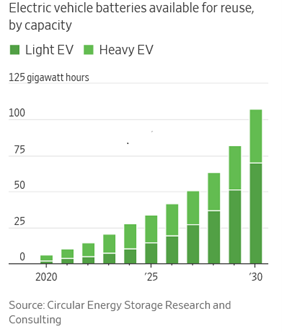
Figure 6: The growth in electric vehicles is also yielding capacity via used “second life” batteries from these vehicles. (Source: Circular Energy Storage Research and Consulting)
ESS designs based on used batteries are not limited to small-scale installations such as homes or small buildings. Some of their design-ins are fairly large, supporting office buildings, malls, and even factories. As with new batteries, these re-purposed battery arrays benefit from the available components and expertise associated with high-volume electric-vehicle technology.
On Grid or Not?
A battery-based ESS can support two basic power-system topologies: Standalone or grid-connected. Either can also be configured as an uninterruptible power system (UPS).
A standalone system has an independent energy source (often but not necessarily renewable) charging the battery array. The load operates from the non-battery source when that source is available and while that source also charges the batteries; when it is unavailable, the load is powered by the batteries alone.
For situations where the grid is available and the connection is practical or desirable, the ESS gets power from the grid and other sources such as intermittent wind and solar. The renewable source is used to power the load and charge the batteries if excess power is available. The sophisticated ESS algorithm balances the allocation of power flow for a combination of highest availability and lowest operating cost.
The grid is used to charge the batteries when the source is available and power costs are the lowest. In turn, the batteries are used when grid costs are high or when renewable sources are not available or are insufficient. By carefully managing the available sources of power and the load situation, the ESS can ensure the highest level of power availability along with lowest costs.
More advanced ESS designs allow for further benefits and overall cost reduction by putting power back into the grid when the batteries are charged and the grid is not needed, as the renewable source can supply the power required. To do this, they use a “bidirectional” ESS power unit, such as those in the EZA series from TDK (Figure 7). These units transparently direct the flow of power from where it is available to where it is needed or can be stored.
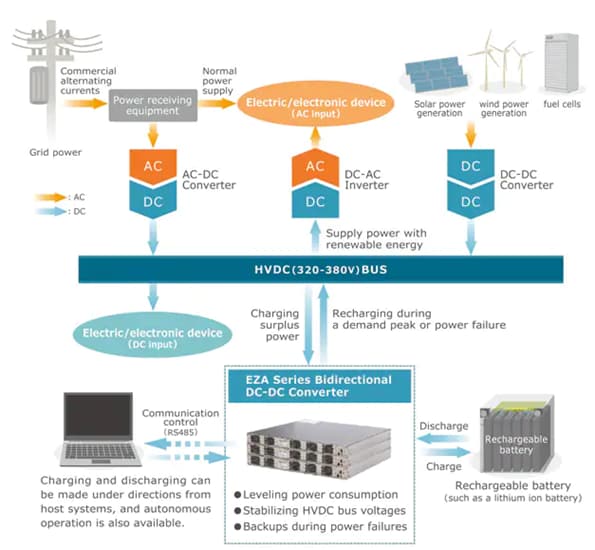
Figure 7: A bidirectional supply allows batteries to be charged, using AC-line power as well as another source, and direct power to where it is needed or can be stored. (Source: TDK)
A battery-backed ESS can also be arranged to function as an uninterrupted power system (UPS) that supports the load regardless of grid availability. UPS topologies come in two versions. The simpler, less costly one is called "offline," and the load operates from the grid; when the grid goes down, the system takes a few seconds to switch to the batteries as the source. The off-line approach is suitable for less critical situations such as a residential backup or when there is a backup generator but no formal energy storage unit (the fuel for the generator represents a form of energy storage, but the generator must be started to use it).
For mission-critical installations such as public safety buildings, hospitals, and even data centers, an online UPS is required. Here, the load is always powered by the batteries, which in turn are continuously being charged by the grid (if available) or an alternate source. The ESS algorithms manage the power flow, and there is no glitch or transients when the source charging the battery— whether grid or other—drops out.
The technologies of the constituent components have now advanced in performance and dropped in cost to the level where these online systems are now available for residential use, as demonstrated by the Generac PWRcell system (Figure 8).
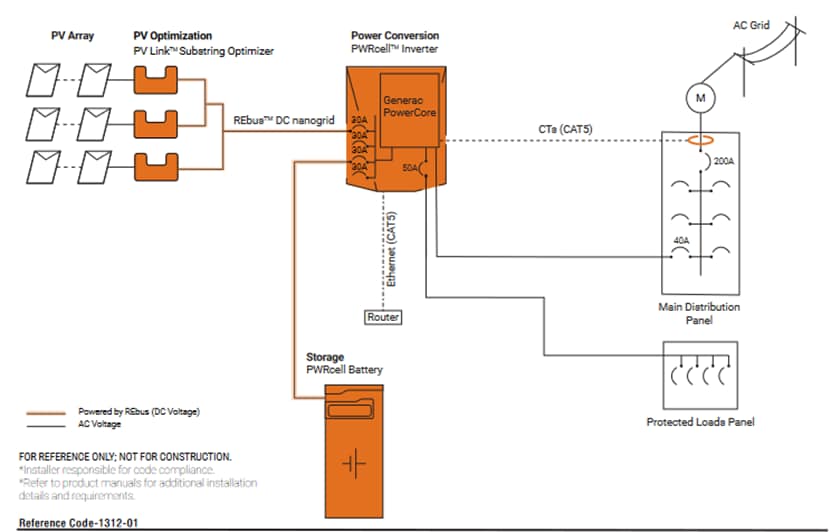
Figure 8: New residential systems such as the Generac PWRcell seamlessly integrate grid power, solar-cell power, and battery-based storage; it can also incorporate an optional generator (not shown). (Source: Generac Power Systems, Inc.)
This system has three seamless modes:
1) Day: Home runs on solar, charges the battery, and sells extra power to the grid.
2) Night: Home runs on battery power, energy use is optimized.
3) During a grid power outage: Run the home on battery, recharge daily with solar, and top-off the battery with an optional generator when needed.
Industry Standards Define Design, Performance
As with many emerging applications, standards play a significant role in growth and acceptance. As widespread use of alternate energy sources and ESS installations becomes a reality, key vendors, regulatory agencies, and professional organizations develop necessary standards encompassing multiple areas:
- Basic safety, since these systems involve high voltages and currents. These standards may be merely an enhanced version of the electrical and building codes which have been in place for many years.
- Siting and physical placement, since an ESS is usually large, heavy, and energy-dense and may have hazardous materials as part of its construction.
- Compatibility, as users want to be able to interconnect units from different supplies with consistency, beginning with the basic hardware level of physical connectors to advanced operational issues.
- Defining how to measure the performance of systems, with standard metrics for key parameters.
- As is often the case, these standards are promulgated by a maze of established and newer organizations, so understanding and following them can be a challenge. The long list of standards covers everything from fundamental tangible installation issues to individual components, subsystems, and overall complete systems. The Resources at the end lists a few sites and sources which can help on this often-bewildering subject.
Conclusion
Energy storage systems are an essential building block of any power-sourcing and -delivery arrangement that relies in part or entirely on an intermittent or unpredictable source. Users have many options for providing this storage, with each having tradeoffs in key electrical, mechanical, and physical performance and installation parameters. Battery-based energy storage is a very attractive option due to its availability, modularity, scalability, energy density, manageability, and noise-free operation.